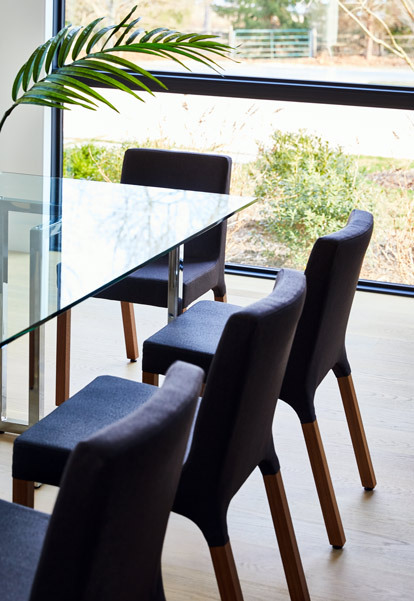

Chairs are, without a question, a favorite of decorators and collectors alike. They often present the most prominent opportunity for infusing personal style within a space, and at a fairly significant scale.
They intentionally, by design, take center stage and serve in part as the face of any room. And, our experiences with them are inherently intimate: With some exceptions, people generally spend the majority of their time enjoying any residential interior seated in some way.
“Chair” is indeed a very broad category, for which there are seemingly limitless subcategories — lounge chair, armchair, desk chair, etc. But when it comes to dining chairs specifically, given their heavy, consistent use, and equally limitless combinations, it’s worth exploring the various styles in the pursuit of identifying the best fit for your East End lifestyle.
When selecting dining chairs for a space, you should first consider what kind of dining is going to be taking place, especially if there are other spaces to dine in the home. There’s a natural sliding scale of formality involved, with, more or less, an outdoor bistro table for two at one end, and a large formal dinner table at the other. Obviously, the chairs should follow suit.
With a two-top bistro or café table (whether indoor or out), I usually find success with casual, un-upholstered chairs with simplified forms made of wood or metal. They might have a ladder, slat, or splat back. Since these are typically not used for multiple-course dining, they don’t require the peak of comfort for long seatings, and should instead inspire a carefree snacking or sipping vibe. As well, to minimize your anxiety for potential spillage, an easy-to-clean material works well.
Somewhere not too far above a casual bistro setting on the formality scale you would arrive at the breakfast room. You know it well: This is the space that is frequently positioned either adjacent to or within a kitchen, and is perfect for everyday resident dining — and certainly not just for breakfast. For these, consider lifestyle factors before making a decision. Are you someone who enjoys a home-cooked meal every night and requires new, comfortable, informal seating for everyday use? Or, do you mostly dine out, and instead would prefer a more form-over-function vintage statement chair? The choice is yours, but in general, I gravitate toward seating here that has a cushioned or soft seat, but not necessarily a fully cushioned back. The chair selected should also have a somewhat minimal weight to allow for easy pulling in and out — especially without damaging the floors if that risk is present. (Felt pads are almost mandatory in every decorator’s arsenal).
At the top of the scale, you arrive at the formal dining room. Outliers and bon vivants aside, these are typically used least often. For most people, they’re designed for entertaining, and for special occasions. They generally require some preparation efforts to look their best and take on multiple personalities throughout the year. When in use, it’s common for multiple courses to be served, and for people to be seated for an hour or more. For clear reasons, comfort should be top of mind, which is why the majority of formal dining rooms that are designed properly feature fully upholstered, cushioned chairs: seat and back. To emulate a quintessential Hamptons vibe, add a custom white or off-white slipcover over each chair. In the case of rectangular tables, consider captain’s chairs with arms for the host(s), and armless side chairs for the guests, for added formality.
Variations in formality aside, shape should also be a top consideration; be sure to choose chairs that coordinate with your table. While rectangular tables can accommodate most chair shapes, there’s a particular kind of elegance that results when pairing curved dining chairs with round or oval tables that is usually not achieved when completely flat-back, rock-solid dining chairs are in place instead. For height, taller backs can provide added support and create a very Frank Lloyd Wright-ian “room-within-a-room” intimacy. Lower backs, on the contrary, open up the room and are well suited for shorter meals.
Regarding materiality, one size does not fit all. For a classic yet relaxed eastern Long Island setting, wood and/or soft natural fabrics like linen, cotton, or even canvas can work quite well. On the other hand, for mid-century or contemporary style homes, Bauhaus derivatives may be more complementary.
As for scale, take close note of the dimensions of the chairs, especially in regards to width. While cramming your guests together is never ideal, there’s always a possibility that an inch or two difference in chair width, multiplied by “x” number of chairs, can make or break the ideal seating capacity that is necessary for your favorite annual holiday gathering.
Clearly, you should also avoid too much rigidity in your selection. While there are certain unspoken no-goes in our staging book (backless dining stools unless space demands it, and dining chairs on wheels, for instance), be sure to collect the dining chairs that really speak to you. Not only are you going to have to live with them, but very literally on them — and, for many of life’s more rewarding, memory-making moments, to boot.
 More Posts from Andrew Bowen
More Posts from Andrew Bowen